Comparative Analysis: Qualitative and Quantitative Research Methods
VerifiedAdded on 2019/10/30
|9
|2000
|1133
Report
AI Summary
This report provides a comprehensive comparison of qualitative and quantitative research methodologies. It begins by defining and contrasting the two approaches, highlighting their distinct characteristics, data collection methods (interviews, surveys, and analysis of social media data), and data analysis techniques (thematic analysis, statistical analysis). The report then delves into the similarities and differences, including their philosophical underpinnings, participant involvement, and the types of data used. It also provides practical examples, such as optimizing transportation costs in a fleet of vehicles and the development of effective employee exit policies. The report emphasizes the importance for leaders in various organizations to understand both methodologies to improve decision-making. It also references two research papers to demonstrate how each methodology can be applied to solve real-world business problems.
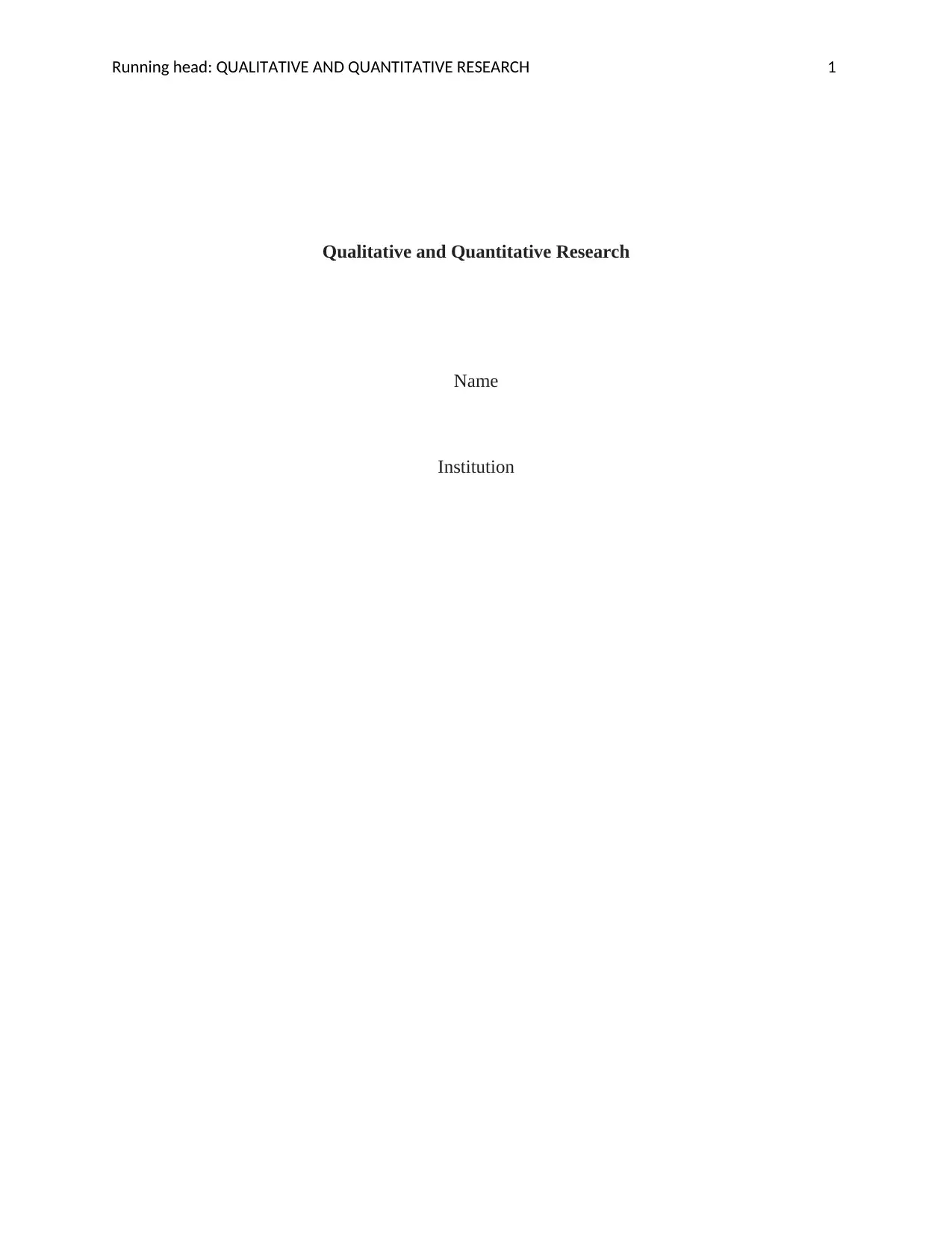
Running head: QUALITATIVE AND QUANTITATIVE RESEARCH 1
Qualitative and Quantitative Research
Name
Institution
Qualitative and Quantitative Research
Name
Institution
Paraphrase This Document
Need a fresh take? Get an instant paraphrase of this document with our AI Paraphraser

QUALITATIVE AND QUANTITATIVE RESEARCH 2
Abstract
Qualitative and quantitative methodologies are two different methodologies that are used in
research. This report focuses on their similarities and differences. These methods can work
independently in an entire research, or they can work together. They involve different ways of
data analysis. This is because qualitative analysis uses numbers while qualitative analysis uses
data in the form of text. The report also contains illustrations of why researchers and leaders in
different organizations require to understand both methodologies. The second question concerns
how transportation costs can be reduced in a fleet of vehicles. The final question provides the
best policies that should be used in an organization when dealing with the exit of an employee.
Abstract
Qualitative and quantitative methodologies are two different methodologies that are used in
research. This report focuses on their similarities and differences. These methods can work
independently in an entire research, or they can work together. They involve different ways of
data analysis. This is because qualitative analysis uses numbers while qualitative analysis uses
data in the form of text. The report also contains illustrations of why researchers and leaders in
different organizations require to understand both methodologies. The second question concerns
how transportation costs can be reduced in a fleet of vehicles. The final question provides the
best policies that should be used in an organization when dealing with the exit of an employee.
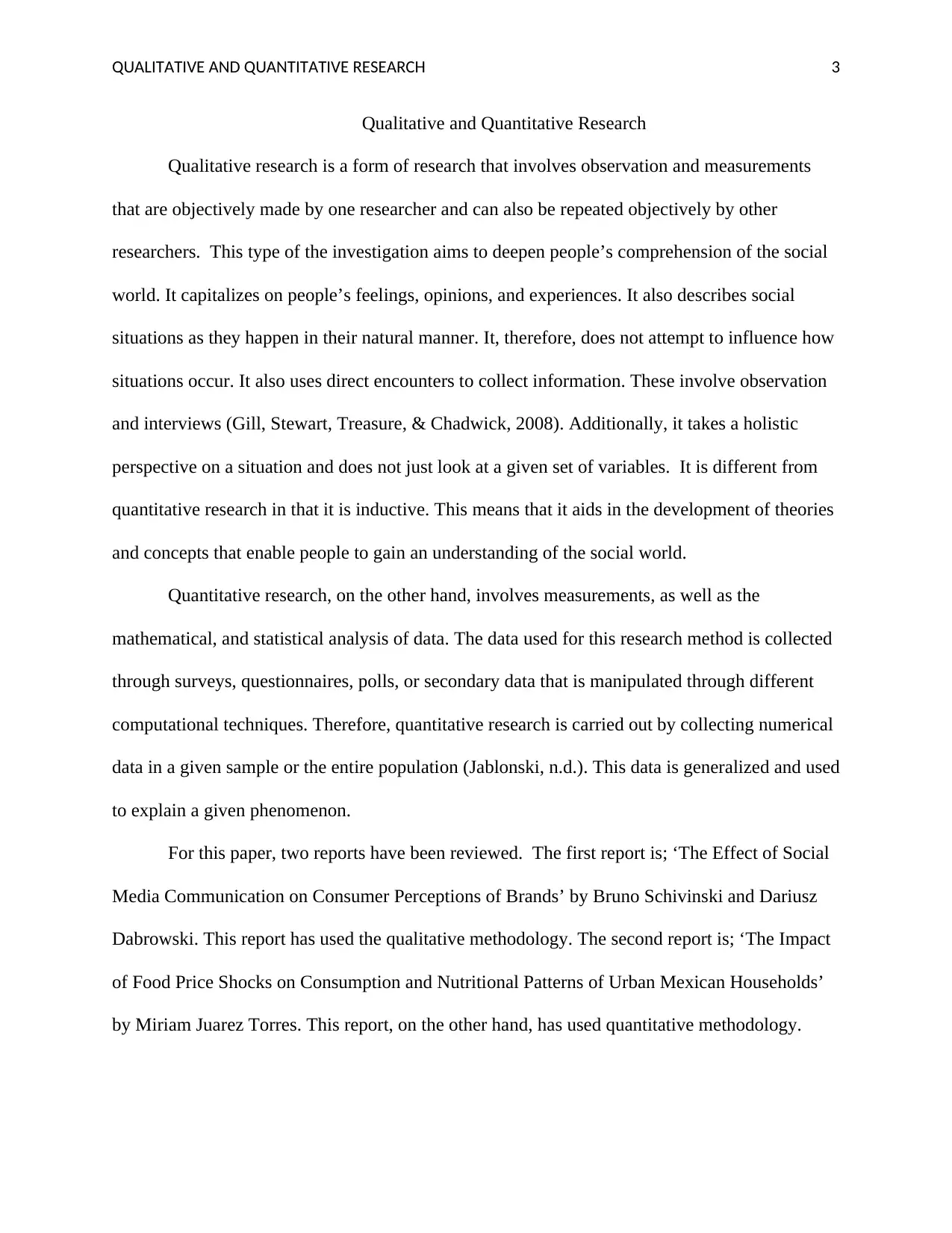
QUALITATIVE AND QUANTITATIVE RESEARCH 3
Qualitative and Quantitative Research
Qualitative research is a form of research that involves observation and measurements
that are objectively made by one researcher and can also be repeated objectively by other
researchers. This type of the investigation aims to deepen people’s comprehension of the social
world. It capitalizes on people’s feelings, opinions, and experiences. It also describes social
situations as they happen in their natural manner. It, therefore, does not attempt to influence how
situations occur. It also uses direct encounters to collect information. These involve observation
and interviews (Gill, Stewart, Treasure, & Chadwick, 2008). Additionally, it takes a holistic
perspective on a situation and does not just look at a given set of variables. It is different from
quantitative research in that it is inductive. This means that it aids in the development of theories
and concepts that enable people to gain an understanding of the social world.
Quantitative research, on the other hand, involves measurements, as well as the
mathematical, and statistical analysis of data. The data used for this research method is collected
through surveys, questionnaires, polls, or secondary data that is manipulated through different
computational techniques. Therefore, quantitative research is carried out by collecting numerical
data in a given sample or the entire population (Jablonski, n.d.). This data is generalized and used
to explain a given phenomenon.
For this paper, two reports have been reviewed. The first report is; ‘The Effect of Social
Media Communication on Consumer Perceptions of Brands’ by Bruno Schivinski and Dariusz
Dabrowski. This report has used the qualitative methodology. The second report is; ‘The Impact
of Food Price Shocks on Consumption and Nutritional Patterns of Urban Mexican Households’
by Miriam Juarez Torres. This report, on the other hand, has used quantitative methodology.
Qualitative and Quantitative Research
Qualitative research is a form of research that involves observation and measurements
that are objectively made by one researcher and can also be repeated objectively by other
researchers. This type of the investigation aims to deepen people’s comprehension of the social
world. It capitalizes on people’s feelings, opinions, and experiences. It also describes social
situations as they happen in their natural manner. It, therefore, does not attempt to influence how
situations occur. It also uses direct encounters to collect information. These involve observation
and interviews (Gill, Stewart, Treasure, & Chadwick, 2008). Additionally, it takes a holistic
perspective on a situation and does not just look at a given set of variables. It is different from
quantitative research in that it is inductive. This means that it aids in the development of theories
and concepts that enable people to gain an understanding of the social world.
Quantitative research, on the other hand, involves measurements, as well as the
mathematical, and statistical analysis of data. The data used for this research method is collected
through surveys, questionnaires, polls, or secondary data that is manipulated through different
computational techniques. Therefore, quantitative research is carried out by collecting numerical
data in a given sample or the entire population (Jablonski, n.d.). This data is generalized and used
to explain a given phenomenon.
For this paper, two reports have been reviewed. The first report is; ‘The Effect of Social
Media Communication on Consumer Perceptions of Brands’ by Bruno Schivinski and Dariusz
Dabrowski. This report has used the qualitative methodology. The second report is; ‘The Impact
of Food Price Shocks on Consumption and Nutritional Patterns of Urban Mexican Households’
by Miriam Juarez Torres. This report, on the other hand, has used quantitative methodology.
⊘ This is a preview!⊘
Do you want full access?
Subscribe today to unlock all pages.

Trusted by 1+ million students worldwide

QUALITATIVE AND QUANTITATIVE RESEARCH 4
The first report, which uses the qualitative methodology, makes use of unstructured and
semi-structured data. Unstructured data is data that is text heavy and not organized in a pre-
defined manner. This includes; social media information, you tube videos, emails among others.
Semi structured data is data that is also not organized in a pre-defined manner but makes use of
markers to highlight important information to make it easier to find. On the other hand, the
second report, which uses quantitative methodology uses structured data. This refers to data that
is in a well-organized in a numerical format and can be easily analyzed.
The two different research methods on the two reports have some similarities. Both
methodologies bring about data reduction, and they respond to research questions. They both
also bring about transparency for the research being conducted. Additionally, both research
methodologies use different data analysis tactics to explain their findings and provide a
conclusion for the given research. Finally, both research methods address issues of error.
However, there are also differences that exist between the two research methodologies.
These differences between qualitative and quantitative research methodologies can be shown in
three areas. These are; in research methodology, in the participants, data collection and analysis,
and finally in values, context, and involvement (Slevitch, 2011).
The research methodology is said to be the overall philosophy under which the research
is pinned. The difference between qualitative and quantitative methodologies of research can be
explained as; causality versus interpretation, realism versus idealism, and hypotheses versus
description. The concept that explains quantitative research is realism. This is because it gives
actual figures- in the form of structured data- that exist in the real world. Idealism, on the other
hand, is used in qualitative research because it deals with opinions. This is seen when data is
collected based on what people are talking about in social media platforms.
The first report, which uses the qualitative methodology, makes use of unstructured and
semi-structured data. Unstructured data is data that is text heavy and not organized in a pre-
defined manner. This includes; social media information, you tube videos, emails among others.
Semi structured data is data that is also not organized in a pre-defined manner but makes use of
markers to highlight important information to make it easier to find. On the other hand, the
second report, which uses quantitative methodology uses structured data. This refers to data that
is in a well-organized in a numerical format and can be easily analyzed.
The two different research methods on the two reports have some similarities. Both
methodologies bring about data reduction, and they respond to research questions. They both
also bring about transparency for the research being conducted. Additionally, both research
methodologies use different data analysis tactics to explain their findings and provide a
conclusion for the given research. Finally, both research methods address issues of error.
However, there are also differences that exist between the two research methodologies.
These differences between qualitative and quantitative research methodologies can be shown in
three areas. These are; in research methodology, in the participants, data collection and analysis,
and finally in values, context, and involvement (Slevitch, 2011).
The research methodology is said to be the overall philosophy under which the research
is pinned. The difference between qualitative and quantitative methodologies of research can be
explained as; causality versus interpretation, realism versus idealism, and hypotheses versus
description. The concept that explains quantitative research is realism. This is because it gives
actual figures- in the form of structured data- that exist in the real world. Idealism, on the other
hand, is used in qualitative research because it deals with opinions. This is seen when data is
collected based on what people are talking about in social media platforms.
Paraphrase This Document
Need a fresh take? Get an instant paraphrase of this document with our AI Paraphraser
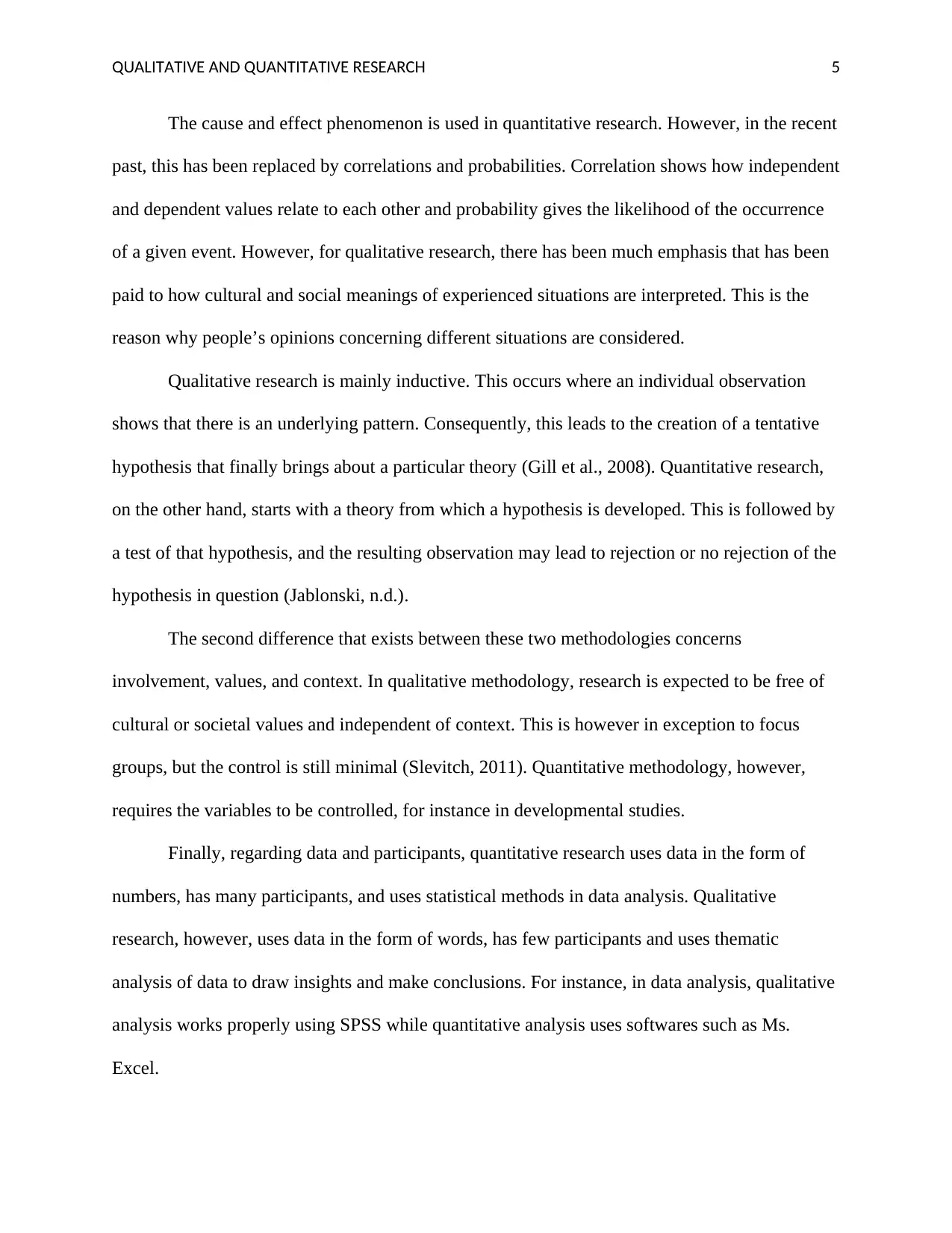
QUALITATIVE AND QUANTITATIVE RESEARCH 5
The cause and effect phenomenon is used in quantitative research. However, in the recent
past, this has been replaced by correlations and probabilities. Correlation shows how independent
and dependent values relate to each other and probability gives the likelihood of the occurrence
of a given event. However, for qualitative research, there has been much emphasis that has been
paid to how cultural and social meanings of experienced situations are interpreted. This is the
reason why people’s opinions concerning different situations are considered.
Qualitative research is mainly inductive. This occurs where an individual observation
shows that there is an underlying pattern. Consequently, this leads to the creation of a tentative
hypothesis that finally brings about a particular theory (Gill et al., 2008). Quantitative research,
on the other hand, starts with a theory from which a hypothesis is developed. This is followed by
a test of that hypothesis, and the resulting observation may lead to rejection or no rejection of the
hypothesis in question (Jablonski, n.d.).
The second difference that exists between these two methodologies concerns
involvement, values, and context. In qualitative methodology, research is expected to be free of
cultural or societal values and independent of context. This is however in exception to focus
groups, but the control is still minimal (Slevitch, 2011). Quantitative methodology, however,
requires the variables to be controlled, for instance in developmental studies.
Finally, regarding data and participants, quantitative research uses data in the form of
numbers, has many participants, and uses statistical methods in data analysis. Qualitative
research, however, uses data in the form of words, has few participants and uses thematic
analysis of data to draw insights and make conclusions. For instance, in data analysis, qualitative
analysis works properly using SPSS while quantitative analysis uses softwares such as Ms.
Excel.
The cause and effect phenomenon is used in quantitative research. However, in the recent
past, this has been replaced by correlations and probabilities. Correlation shows how independent
and dependent values relate to each other and probability gives the likelihood of the occurrence
of a given event. However, for qualitative research, there has been much emphasis that has been
paid to how cultural and social meanings of experienced situations are interpreted. This is the
reason why people’s opinions concerning different situations are considered.
Qualitative research is mainly inductive. This occurs where an individual observation
shows that there is an underlying pattern. Consequently, this leads to the creation of a tentative
hypothesis that finally brings about a particular theory (Gill et al., 2008). Quantitative research,
on the other hand, starts with a theory from which a hypothesis is developed. This is followed by
a test of that hypothesis, and the resulting observation may lead to rejection or no rejection of the
hypothesis in question (Jablonski, n.d.).
The second difference that exists between these two methodologies concerns
involvement, values, and context. In qualitative methodology, research is expected to be free of
cultural or societal values and independent of context. This is however in exception to focus
groups, but the control is still minimal (Slevitch, 2011). Quantitative methodology, however,
requires the variables to be controlled, for instance in developmental studies.
Finally, regarding data and participants, quantitative research uses data in the form of
numbers, has many participants, and uses statistical methods in data analysis. Qualitative
research, however, uses data in the form of words, has few participants and uses thematic
analysis of data to draw insights and make conclusions. For instance, in data analysis, qualitative
analysis works properly using SPSS while quantitative analysis uses softwares such as Ms.
Excel.

QUALITATIVE AND QUANTITATIVE RESEARCH 6
Managers and leaders in different organizations ought to have a comprehension of both
research methodologies. This will aid in running their organizations based on facts coupled with
their intuition. Both qualitative and quantitative methods can help in automated decision making
in this age of technology. For instance; customer and competitor behavior can be analyzed,
supply chains which are more complex today can be improved by taking advantage of structured,
semi structured, and unstructured data.
From the reports, both qualitative and quantitative methodologies have been used to draw
insights and make decisions. The report on the impact of food price shocks on consumption
requires quantitative data. Upon analysis of the data, the report concludes that there is a negative
correlation between the food prices and nutritious food consumption (Torres, 2015). This means
that the higher the food prices, the lower the amount of nutritious food consumed.
The report concerning how consumer perceptions are affected by social media
communication, which is a qualitative research shows that by researching on consumers’ tastes
companies can provide the most profitable products (Schivinski & Dabrowski, 2014). This
research is carried out by observing what people say in social media and analyzing that
information.
It is clear that both qualitative and quantitative approaches in research are vital. Decision
makers and researchers should therefore not deal strictly in either methodology but use both
collaboratively. By so doing, decisions will be higher quality and better reflect the situation on
the ground.
Managers and leaders in different organizations ought to have a comprehension of both
research methodologies. This will aid in running their organizations based on facts coupled with
their intuition. Both qualitative and quantitative methods can help in automated decision making
in this age of technology. For instance; customer and competitor behavior can be analyzed,
supply chains which are more complex today can be improved by taking advantage of structured,
semi structured, and unstructured data.
From the reports, both qualitative and quantitative methodologies have been used to draw
insights and make decisions. The report on the impact of food price shocks on consumption
requires quantitative data. Upon analysis of the data, the report concludes that there is a negative
correlation between the food prices and nutritious food consumption (Torres, 2015). This means
that the higher the food prices, the lower the amount of nutritious food consumed.
The report concerning how consumer perceptions are affected by social media
communication, which is a qualitative research shows that by researching on consumers’ tastes
companies can provide the most profitable products (Schivinski & Dabrowski, 2014). This
research is carried out by observing what people say in social media and analyzing that
information.
It is clear that both qualitative and quantitative approaches in research are vital. Decision
makers and researchers should therefore not deal strictly in either methodology but use both
collaboratively. By so doing, decisions will be higher quality and better reflect the situation on
the ground.
⊘ This is a preview!⊘
Do you want full access?
Subscribe today to unlock all pages.

Trusted by 1+ million students worldwide

QUALITATIVE AND QUANTITATIVE RESEARCH 7
How transportation costs for a fleet of delivery trucks can be reduced
With the rising price of fuel, businesses that carry out transportation activities need to
find ways to minimize their transportation costs and avoid making losses. There are many
technologies that companies are deploying to compare different scenarios and routes, while still
keeping time.
One way to reduce transportation costs is by optimizing routes and proper scheduling.
This involves finding the shortest route and ensuring drivers know where they are expected to be
at all times. This ensures that idle time is minimized and deliveries are done on time. Driver
behavior should also be controlled to ensure that they do not use the vehicles or unintended
purposes. Moreover, driver territories can be optimized to assist companies in calculating the
compactness of different areas, and the transportation workloads (Salter, 2017).
How transportation costs for a fleet of delivery trucks can be reduced
With the rising price of fuel, businesses that carry out transportation activities need to
find ways to minimize their transportation costs and avoid making losses. There are many
technologies that companies are deploying to compare different scenarios and routes, while still
keeping time.
One way to reduce transportation costs is by optimizing routes and proper scheduling.
This involves finding the shortest route and ensuring drivers know where they are expected to be
at all times. This ensures that idle time is minimized and deliveries are done on time. Driver
behavior should also be controlled to ensure that they do not use the vehicles or unintended
purposes. Moreover, driver territories can be optimized to assist companies in calculating the
compactness of different areas, and the transportation workloads (Salter, 2017).
Paraphrase This Document
Need a fresh take? Get an instant paraphrase of this document with our AI Paraphraser
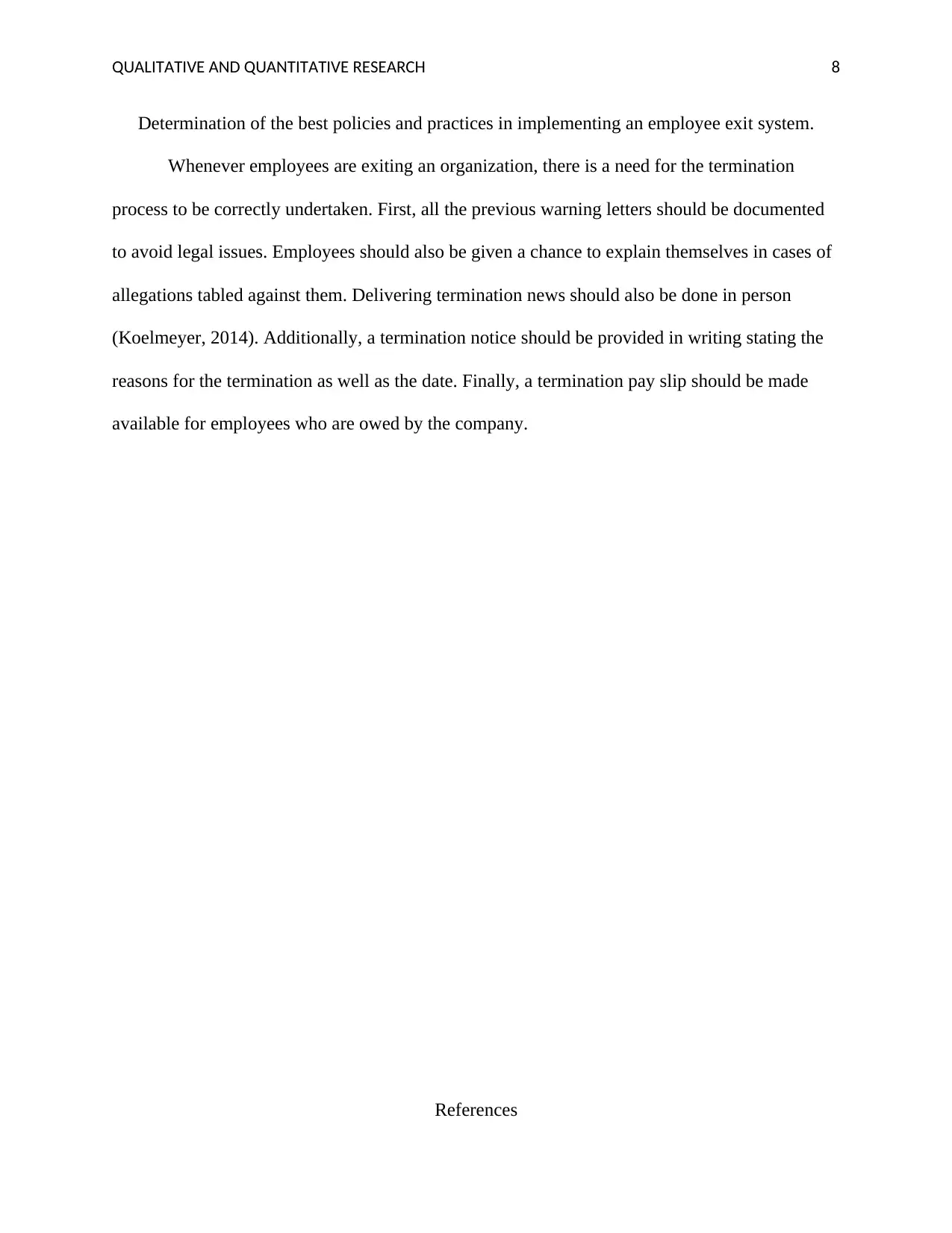
QUALITATIVE AND QUANTITATIVE RESEARCH 8
Determination of the best policies and practices in implementing an employee exit system.
Whenever employees are exiting an organization, there is a need for the termination
process to be correctly undertaken. First, all the previous warning letters should be documented
to avoid legal issues. Employees should also be given a chance to explain themselves in cases of
allegations tabled against them. Delivering termination news should also be done in person
(Koelmeyer, 2014). Additionally, a termination notice should be provided in writing stating the
reasons for the termination as well as the date. Finally, a termination pay slip should be made
available for employees who are owed by the company.
References
Determination of the best policies and practices in implementing an employee exit system.
Whenever employees are exiting an organization, there is a need for the termination
process to be correctly undertaken. First, all the previous warning letters should be documented
to avoid legal issues. Employees should also be given a chance to explain themselves in cases of
allegations tabled against them. Delivering termination news should also be done in person
(Koelmeyer, 2014). Additionally, a termination notice should be provided in writing stating the
reasons for the termination as well as the date. Finally, a termination pay slip should be made
available for employees who are owed by the company.
References
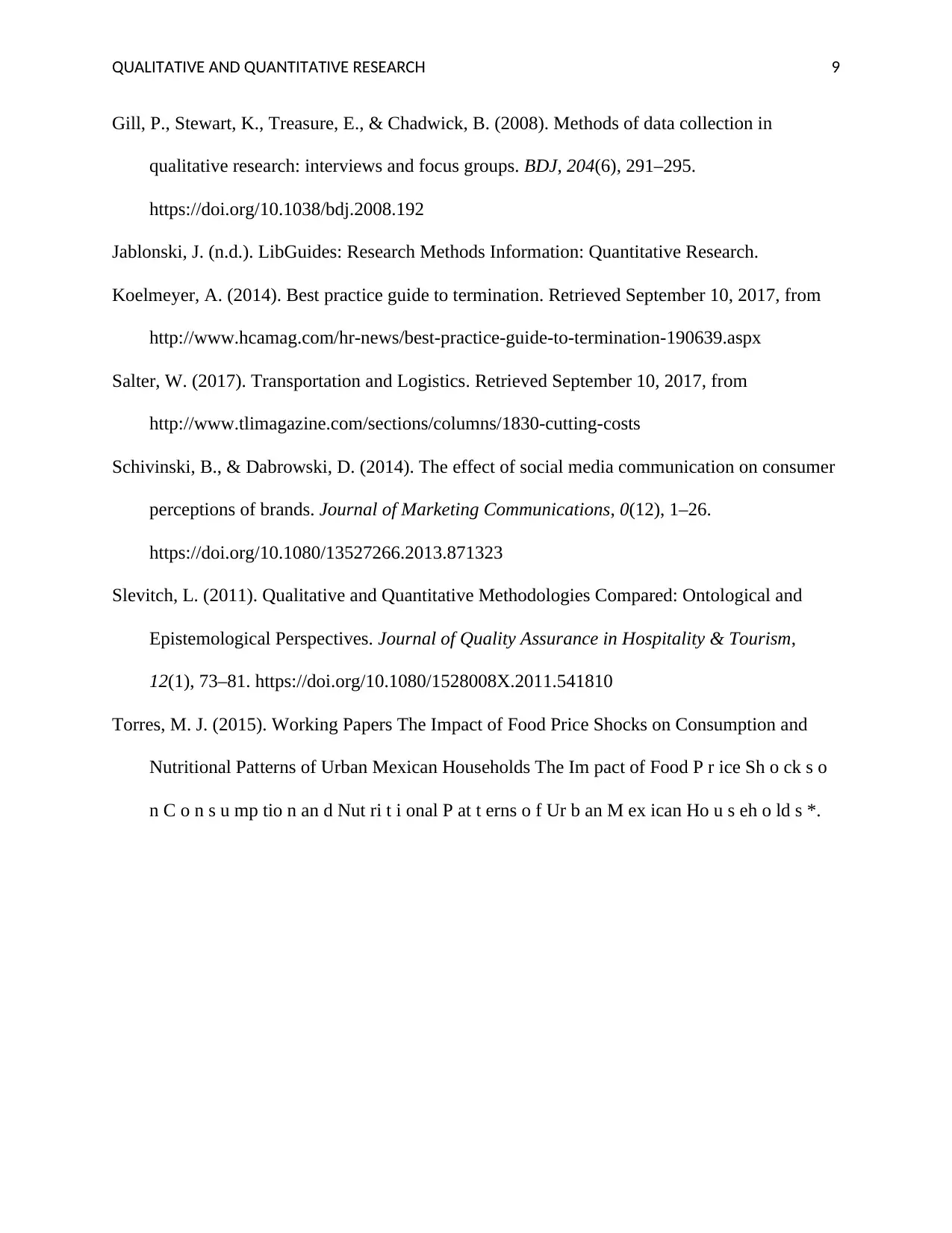
QUALITATIVE AND QUANTITATIVE RESEARCH 9
Gill, P., Stewart, K., Treasure, E., & Chadwick, B. (2008). Methods of data collection in
qualitative research: interviews and focus groups. BDJ, 204(6), 291–295.
https://doi.org/10.1038/bdj.2008.192
Jablonski, J. (n.d.). LibGuides: Research Methods Information: Quantitative Research.
Koelmeyer, A. (2014). Best practice guide to termination. Retrieved September 10, 2017, from
http://www.hcamag.com/hr-news/best-practice-guide-to-termination-190639.aspx
Salter, W. (2017). Transportation and Logistics. Retrieved September 10, 2017, from
http://www.tlimagazine.com/sections/columns/1830-cutting-costs
Schivinski, B., & Dabrowski, D. (2014). The effect of social media communication on consumer
perceptions of brands. Journal of Marketing Communications, 0(12), 1–26.
https://doi.org/10.1080/13527266.2013.871323
Slevitch, L. (2011). Qualitative and Quantitative Methodologies Compared: Ontological and
Epistemological Perspectives. Journal of Quality Assurance in Hospitality & Tourism,
12(1), 73–81. https://doi.org/10.1080/1528008X.2011.541810
Torres, M. J. (2015). Working Papers The Impact of Food Price Shocks on Consumption and
Nutritional Patterns of Urban Mexican Households The Im pact of Food P r ice Sh o ck s o
n C o n s u mp tio n an d Nut ri t i onal P at t erns o f Ur b an M ex ican Ho u s eh o ld s *.
Gill, P., Stewart, K., Treasure, E., & Chadwick, B. (2008). Methods of data collection in
qualitative research: interviews and focus groups. BDJ, 204(6), 291–295.
https://doi.org/10.1038/bdj.2008.192
Jablonski, J. (n.d.). LibGuides: Research Methods Information: Quantitative Research.
Koelmeyer, A. (2014). Best practice guide to termination. Retrieved September 10, 2017, from
http://www.hcamag.com/hr-news/best-practice-guide-to-termination-190639.aspx
Salter, W. (2017). Transportation and Logistics. Retrieved September 10, 2017, from
http://www.tlimagazine.com/sections/columns/1830-cutting-costs
Schivinski, B., & Dabrowski, D. (2014). The effect of social media communication on consumer
perceptions of brands. Journal of Marketing Communications, 0(12), 1–26.
https://doi.org/10.1080/13527266.2013.871323
Slevitch, L. (2011). Qualitative and Quantitative Methodologies Compared: Ontological and
Epistemological Perspectives. Journal of Quality Assurance in Hospitality & Tourism,
12(1), 73–81. https://doi.org/10.1080/1528008X.2011.541810
Torres, M. J. (2015). Working Papers The Impact of Food Price Shocks on Consumption and
Nutritional Patterns of Urban Mexican Households The Im pact of Food P r ice Sh o ck s o
n C o n s u mp tio n an d Nut ri t i onal P at t erns o f Ur b an M ex ican Ho u s eh o ld s *.
⊘ This is a preview!⊘
Do you want full access?
Subscribe today to unlock all pages.

Trusted by 1+ million students worldwide
1 out of 9
Related Documents
Your All-in-One AI-Powered Toolkit for Academic Success.
+13062052269
info@desklib.com
Available 24*7 on WhatsApp / Email
![[object Object]](/_next/static/media/star-bottom.7253800d.svg)
Unlock your academic potential
Copyright © 2020–2025 A2Z Services. All Rights Reserved. Developed and managed by ZUCOL.





